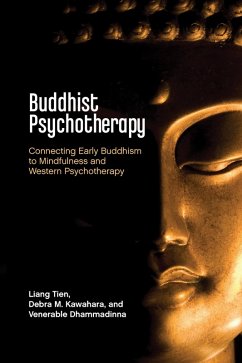Liang Tien, Debra M Kawahara, Venerable Dhammadinna
Buddhist Psychotherapy
Connecting Early Buddhism to Mindfulness and Western Psychotherapy
Liang Tien, Debra M Kawahara, Venerable Dhammadinna
Buddhist Psychotherapy
Connecting Early Buddhism to Mindfulness and Western Psychotherapy
- Broschiertes Buch
- Merkliste
- Auf die Merkliste
- Bewerten Bewerten
- Teilen
- Produkt teilen
- Produkterinnerung
- Produkterinnerung
This book applies ancient Buddhist philosophy to modern psychotherapy, showing how mindfulness can help clients alleviate suffering.
Andere Kunden interessierten sich auch für
![Nostalgia Nostalgia]() Clay RoutledgeNostalgia65,99 €
Clay RoutledgeNostalgia65,99 €![Existential Social Work Existential Social Work]() Zvi EisikovitsExistential Social Work39,99 €
Zvi EisikovitsExistential Social Work39,99 €![Heideggerian Existential Therapy Heideggerian Existential Therapy]() Mo MandicHeideggerian Existential Therapy29,99 €
Mo MandicHeideggerian Existential Therapy29,99 €![Loss, Grief and Existential Awareness Loss, Grief and Existential Awareness]() Mai-Britt GuldinLoss, Grief and Existential Awareness37,99 €
Mai-Britt GuldinLoss, Grief and Existential Awareness37,99 €![Man's Search For Meaning Man's Search For Meaning]() Viktor E FranklMan's Search For Meaning21,99 €
Viktor E FranklMan's Search For Meaning21,99 €![Man's Search For Meaning Man's Search For Meaning]() Viktor E FranklMan's Search For Meaning9,99 €
Viktor E FranklMan's Search For Meaning9,99 €![Existential Psychotherapy Existential Psychotherapy]() Irvin YalomExistential Psychotherapy76,99 €
Irvin YalomExistential Psychotherapy76,99 €-
-
-
This book applies ancient Buddhist philosophy to modern psychotherapy, showing how mindfulness can help clients alleviate suffering.
Produktdetails
- Produktdetails
- Verlag: American Psychological Association (APA)
- Seitenzahl: 388
- Erscheinungstermin: 23. September 2025
- Englisch
- ISBN-13: 9781433841637
- ISBN-10: 1433841630
- Artikelnr.: 71977159
- Herstellerkennzeichnung
- Libri GmbH
- Europaallee 1
- 36244 Bad Hersfeld
- gpsr@libri.de
- Verlag: American Psychological Association (APA)
- Seitenzahl: 388
- Erscheinungstermin: 23. September 2025
- Englisch
- ISBN-13: 9781433841637
- ISBN-10: 1433841630
- Artikelnr.: 71977159
- Herstellerkennzeichnung
- Libri GmbH
- Europaallee 1
- 36244 Bad Hersfeld
- gpsr@libri.de
Dr. Liang Tien (Tien) is a retired Professor from the California School of Professional Psychology PsyD Program – Hong Kong. Since retirement, she has earned a PhD in Buddhist Studies at the University of Kelaniya, Sri Lanka, and is a co-founder of the Illumination of Mindfulness Institute at Alliant International University. She is a long-time meditator. As a licensed clinical psychologist, her independent practice focuses on individuals with ancestry from Asian Buddhist-based countries and woman with histories of abuse. Her research interest has been in ethics and immigrant acculturation. Dr. Debra M. Kawahara is the Associate Dean of Academic Affairs and Distinguished Professor at the California School of Professional Psychology, Alliant International University. She is the 2025 American Psychological Association President. As a licensed clinical psychologist, her independent practice focuses on psychotherapy with individuals, couples, and families, as well as consulting and conducting trainings to organizations. Further, Dr. Kawahara is a multicultural feminist scholar whose work centers on intersectionality, Buddhist psychotherapy, women’s issues, leadership, and the application of multicultural, feminist, and social justice principles in practice. She is widely published and has presented nationally and globally. Ven. Dhammadinna took robes in 1983 at the age of 25. From 1985 until 2006 she studied under several esteemed meditation teachers in Southeast Asia and India, namely Ven. U Pandita Sayadaw, Dipama Barua, Ajahn Buddhadasa, Ajahn Sumedho, and His Holiness the Dalai Lama. She began teaching retreats in 1989. In 2006 she accepted an invitation to return to the States and is a resident teacher at Bodhiheart Sangha Buddhist Meditation Center. Visit https://bodhiheart.wpcomstaging.com.
Prologue: Our Background and Interest in Linking Buddhism with
Psychotherapy
Introduction: Linking Western Mindfulness to Early Buddhism
Part I. Foundations of Buddhism and Buddhist Psychotherapy
Chapter 1. Background on the Buddha and Early Buddhist Texts
Chapter 2. Buddhist Psychotherapy Versus Buddhism the Religion
Part II. Impermanence
Chapter 3. Impermanence
Part III. Not-Self
Chapter 4. The Five Aggregates: Component Parts of How Humans Experience
Existence
Chapter 5. How the Five Aggregates Work Together
Chapter 6. How We Construct a Notion of a Self
Part IV. Dukkha
Chapter 7. Dukkha Defined
Chapter 8. The First Dukkha: Suffering Due to Birth, Aging, and Death
Chapter 9. The Second Dukkha: Suffering Due to Situational Change
Chapter 10. The Third Dukkha: Suffering Due to Mental Formations
Chapter 11. The Fourth Dukkha: Suffering Due to the Notion of a Self
Chapter 12. The Cause and Remedy of Dukkha: The Second and Third Noble
Truths
Part V. Interventions and Clinical Implications
Chapter 13. Assessment
Chapter 14. Employing the First Track of the Eightfold Path in
Psychotherapy: Conduct
Chapter 15. Employing the Second Track of the Eightfold Path in
Psychotherapy: Mindfulness
Chapter 16. Advanced Mindfulness in Psychotherapy: What to Contemplate in
Meditation and Why
Chapter 17. Employing the Third Track of the Eightfold Path in
Psychotherapy: Wisdom
Chapter 18. Three Arenas for Intervention in Buddhist Psychotherapy: A
Model and Case Examples
Afterword: Summary and Future Directions
References
Glossary of Pali Terms
Psychotherapy
Introduction: Linking Western Mindfulness to Early Buddhism
Part I. Foundations of Buddhism and Buddhist Psychotherapy
Chapter 1. Background on the Buddha and Early Buddhist Texts
Chapter 2. Buddhist Psychotherapy Versus Buddhism the Religion
Part II. Impermanence
Chapter 3. Impermanence
Part III. Not-Self
Chapter 4. The Five Aggregates: Component Parts of How Humans Experience
Existence
Chapter 5. How the Five Aggregates Work Together
Chapter 6. How We Construct a Notion of a Self
Part IV. Dukkha
Chapter 7. Dukkha Defined
Chapter 8. The First Dukkha: Suffering Due to Birth, Aging, and Death
Chapter 9. The Second Dukkha: Suffering Due to Situational Change
Chapter 10. The Third Dukkha: Suffering Due to Mental Formations
Chapter 11. The Fourth Dukkha: Suffering Due to the Notion of a Self
Chapter 12. The Cause and Remedy of Dukkha: The Second and Third Noble
Truths
Part V. Interventions and Clinical Implications
Chapter 13. Assessment
Chapter 14. Employing the First Track of the Eightfold Path in
Psychotherapy: Conduct
Chapter 15. Employing the Second Track of the Eightfold Path in
Psychotherapy: Mindfulness
Chapter 16. Advanced Mindfulness in Psychotherapy: What to Contemplate in
Meditation and Why
Chapter 17. Employing the Third Track of the Eightfold Path in
Psychotherapy: Wisdom
Chapter 18. Three Arenas for Intervention in Buddhist Psychotherapy: A
Model and Case Examples
Afterword: Summary and Future Directions
References
Glossary of Pali Terms
Prologue: Our Background and Interest in Linking Buddhism with
Psychotherapy
Introduction: Linking Western Mindfulness to Early Buddhism
Part I. Foundations of Buddhism and Buddhist Psychotherapy
Chapter 1. Background on the Buddha and Early Buddhist Texts
Chapter 2. Buddhist Psychotherapy Versus Buddhism the Religion
Part II. Impermanence
Chapter 3. Impermanence
Part III. Not-Self
Chapter 4. The Five Aggregates: Component Parts of How Humans Experience
Existence
Chapter 5. How the Five Aggregates Work Together
Chapter 6. How We Construct a Notion of a Self
Part IV. Dukkha
Chapter 7. Dukkha Defined
Chapter 8. The First Dukkha: Suffering Due to Birth, Aging, and Death
Chapter 9. The Second Dukkha: Suffering Due to Situational Change
Chapter 10. The Third Dukkha: Suffering Due to Mental Formations
Chapter 11. The Fourth Dukkha: Suffering Due to the Notion of a Self
Chapter 12. The Cause and Remedy of Dukkha: The Second and Third Noble
Truths
Part V. Interventions and Clinical Implications
Chapter 13. Assessment
Chapter 14. Employing the First Track of the Eightfold Path in
Psychotherapy: Conduct
Chapter 15. Employing the Second Track of the Eightfold Path in
Psychotherapy: Mindfulness
Chapter 16. Advanced Mindfulness in Psychotherapy: What to Contemplate in
Meditation and Why
Chapter 17. Employing the Third Track of the Eightfold Path in
Psychotherapy: Wisdom
Chapter 18. Three Arenas for Intervention in Buddhist Psychotherapy: A
Model and Case Examples
Afterword: Summary and Future Directions
References
Glossary of Pali Terms
Psychotherapy
Introduction: Linking Western Mindfulness to Early Buddhism
Part I. Foundations of Buddhism and Buddhist Psychotherapy
Chapter 1. Background on the Buddha and Early Buddhist Texts
Chapter 2. Buddhist Psychotherapy Versus Buddhism the Religion
Part II. Impermanence
Chapter 3. Impermanence
Part III. Not-Self
Chapter 4. The Five Aggregates: Component Parts of How Humans Experience
Existence
Chapter 5. How the Five Aggregates Work Together
Chapter 6. How We Construct a Notion of a Self
Part IV. Dukkha
Chapter 7. Dukkha Defined
Chapter 8. The First Dukkha: Suffering Due to Birth, Aging, and Death
Chapter 9. The Second Dukkha: Suffering Due to Situational Change
Chapter 10. The Third Dukkha: Suffering Due to Mental Formations
Chapter 11. The Fourth Dukkha: Suffering Due to the Notion of a Self
Chapter 12. The Cause and Remedy of Dukkha: The Second and Third Noble
Truths
Part V. Interventions and Clinical Implications
Chapter 13. Assessment
Chapter 14. Employing the First Track of the Eightfold Path in
Psychotherapy: Conduct
Chapter 15. Employing the Second Track of the Eightfold Path in
Psychotherapy: Mindfulness
Chapter 16. Advanced Mindfulness in Psychotherapy: What to Contemplate in
Meditation and Why
Chapter 17. Employing the Third Track of the Eightfold Path in
Psychotherapy: Wisdom
Chapter 18. Three Arenas for Intervention in Buddhist Psychotherapy: A
Model and Case Examples
Afterword: Summary and Future Directions
References
Glossary of Pali Terms








